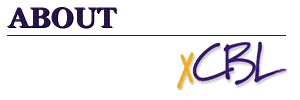
 |
|
|


The XML Common Business Library (xCBL) is a set of XML building blocks and a document framework that allows the creation of robust, reusable, XML documents to facilitate global trading. It essentially serves one language that all participants in e-commerce can understand. This interoperability allows businesses everywhere to easily exchange documents for e-commerce, giving global access to buyers, suppliers, and providers of business services. xCBL 4.0, the latest version, provides a smooth migration path from EDI-based commerce because of its origins in EDI semantics. xCBL will be able to support all essential documents and transactions for global e-commerce including multi-company supply chain automation, direct and indirect procurement, planning, auctions, and invoicing and payment in an international multi-currency environment. xCBL 4.0 is the first version that uses XSDL as the canonical form. Previous versions all used SOX. xCBL is the result of extensive collaboration between Commerce One® and the leading XML standards bodies, e-commerce enterprises, and hardware and software vendors, as well as analysis of existing e-commerce standards including Electronic Data Interchange (EDI) and RosettaNet, Industry leaders Compaq, Microsoft, SAPMarkets, and Sun Microsystems are leveraging xCBL 3.0 and xCBL 3.5 as a key standard in the development and delivery of business-to-business solutions. The Evolution of xCBL In January of 1999, Commerce One acquired Veo Systems and the CBL technology. Commerce One saw the vision of conducting business electronically using XML that it embodied would help complete its transformation from an e-procurement company to a business internet company, and indeed, would transform the concept of e-commerce. The Veo CBL was tailored to support the Commerce One products and customers, which entailed making it interoperable with EDI (Electronic Data Interchange). This led to the creation of xCBL 2.0, and at that time the "x" was added to reflect the relationship with XML. xCBL 2.0 added a strong non-proprietary and interoperable semantic foundation for CBL, and gave companies using EDI a way to transform those applications to XML. xCBL 3.0, released in December of 2000, represented a major broadening of scope and is more powerful than xCBL 2.0. It is rich enough to encode any e-commerce standard, and allows users to build customized documents from standard components. xCBL 3.0 saves developers and integrators enormous amounts of time and effort, and ensures that recipients are able to understand all documents that they receive when doing e-commerce. With version 3.5 of xCBL, support for the W3C Schema (full recommendation) is provided. This means that you could now choose between Commerce One's SOX, the W3C XSDL, Microsoft's XDR as well as the original DTDs when developing solutions that use xCBL. Only minimal changes to the document instance are required; please see the following link for more information xCBL User's Group Newsletter. With the latest release, xCBL 4.0, XSDL is used as the schema canonical form and some initial alignment with standards defined by UBL . The Future of xCBL In Feb, 2003, UBL released the Op70 version for public review which included the Library Content part of UBL that specifies a library of business information entities to be used in the construction of business documents. The release also included a set of common XML business documents assembled from those entities. UBL does not replace xCBL in the short term; it is in its development phase. Currently UBL does not contain the depth and breadth of components and documents that are in xCBL. As UBL continues to develop xCBL will migrate to this standard. Many of the business information entities developed as part of the UBL initiative have equivalents in xCBL. These new UBL components will replace their xCBL equivalents in future releases of xCBL on a phased basis. In the short term, it is unlikely that there will be UBL components for all the existing xCBL components although eventually most existing xCBL components and probably many of the xCBL document structures will be completely replaced by their UBL equivalents and mapping of existing xCBL documents to UBL documents will take place. Commerce One also plans to publish mappings from xCBL to UBL to make it even easier for xCBL implementers to migrate.
|
||||||
|
||||